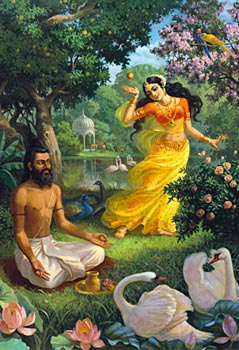 Purvachitti was one of the Apsarasas of the Devika or divine class who was married to Agnidhra. Agnidhra was the eldest son of Priyavrata who was given the largest island of Jambu by his father.
Purvachitti was one of the Apsarasas of the Devika or divine class who was married to Agnidhra. Agnidhra was the eldest son of Priyavrata who was given the largest island of Jambu by his father.
There is a mythical story relating to the life of Agnidhra and Purvachitti. Agnidhra ruled cleverly in kingdom and desired to continue his dynasty and wanted a perfect son. He thought that in order to have a perfect son he would need a perfect wife. So he went to the foot of the Mandara hill where the Apsarasas from heaven often came to enjoy the natural beauty. In order to fulfill the wishes of Agnidhra, Brahma sent the Apsara Purvachitti to marry Agnidhra and bear his children.
Agnidhra was meditating when he was disturbed by the chinking of her anklets. He was totally love-struck by the mesmerizing beauty of Purvachitti. He began to entice the Apsara by praising the various parts of her body using appropriate metaphors.
Agnidhra praised every part of Purvachitti`s body. He said that her eyebrows became bows from which she fired looks that could kill. Her hips were compared to the sweet-smelling Kadamba flowers and her breasts decorated with red powder were likened to the rising sun. Purvachitti`s face was to a tranquil lake in which her eyes were like restless fish. Her pearl white teeth like a row of swans and her black long hair like a swarm of bees. Agnidhra proposes Purvachitti and tells her marry him.
Purvachitti accepted the proposal generously and spent many thousands of years enjoying marital pleasures with Agnidhra. Purvachitti gave birth to nine handsome sons. They were named Nabhi, Kimpurusha, Harivarsha, Ilavrita, Ramyaka, Hiranmaya, Kuru, Bhadrashva and Ketumala. Once the children grew up, Purvachitti told Agnidhra that she had fulfilled her duties and now had to return to heaven.
Purvachitti had no other choice but to return to heaven and Agnidhra knew that. He missed the presence of Purvachitti as they had spent together and longed for her touch. He divided the island of Jambu into nine regions and gave each son one region to rule. Each region came to be named after the son of Agnidhra who ruled it.
Agnidhra meditated and prayed to Lord Brahma, so that he is allowed to dwell in heaven and live with his wife Purvachitti. For the Purna or merits or virtues he had earned in his life, Agnidhra`s aspiration was granted. Agnidhra`s his nine sons married the nine daughters of Meru and got settled in their family life.




















